Table of Contents
Best RV Roof Sealant vs RV Roof Coating – Best Roof Sealants Review
Water damage is perhaps the greatest worry of individuals on wheels. In addition to the problem of the piping system, rooftop spills, and roof leaks are the absolute most stressful. Campers need consistent support and maintenance, which includes preventing roof leaks. Luckily, RV water leaks on the roof are relatively easy to repair with the appropriate RV roof sealant. If you make an annual maintenance plan, you can prevent leaks from the start by using the right RV roof coating. High-quality RV roof sealant is a simple and long-lasting solution to prevent rainwater from entering the RV, camper, and camper van. Let’s review together What are the Best RV Roof Sealants, RV Roof Coating, Sealant vs. Coating, RV roof sealant tape options, and rubber roof sealants for RVs.
In this article, we will introduce the fundamentals of what is an RV Roof Sealant and What is the Best RV Roof Sealant, How to Use an RV Roof Sealant, the difference when choosing an RV roof sealant vs RV roof coating, Best Roof Sealants, and How to apply RV Roof Sealant and Coating.
When you want to get out of town and enjoy the best things that nature has to offer, your camper van provides a comfortable and peaceful place. At the point when you are miles away from the civilized world, the downpour of a leaky roof will hinder your vacation, so you need to choose the best camper car sealant.
However, with the market flooded with high-quality sealants and roof coatings, there’s no need to put off repairing a leaky roof until it’s too late. Maintaining the RV roof with an RV coating or sealing cracks and water leaks in the roof of your RV using RV roof sealing can save you thousands of dollars in expensive repairs. So, whether you’re looking to repair a leaky roof or would like to do annual maintenance on your RV roof, we’ll help you choose the best sealants and coatings to help you solve your leak problem. Best reviews and recommendations for RV sealant and roof coatings.
In any case, with the market overwhelmed with great sealants and rooftop coatings, there’s no compelling reason to put off fixing a broken rooftop until it’s past the point of no return. Covering or fixing a harmed rooftop can save you a large number of dollars in fixes. Along these lines, regardless of whether you’re hoping to fix a broken rooftop or might want to do yearly support on your RV rooftop, we’ll assist you with picking the best sealants and coatings to assist you in taking care of your whole issue. Best audits and proposals for RV sealant and rooftop coatings.
Best RV Roof Sealants
Some RV roof maintenance tips to protect your RV includes among your routine activities such as cleaning, protection, and inspection.
While you’re busy cleaning, stocking, and organizing your RV for a fall scenic drive, fishing trip, weekend getaway, or your next vacation, don’t forget one vital task: RV roof maintenance. Neglecting inspections or maintenance could lead to serious moisture damage down the road or during RV storage.
A few simple steps can help you safely keep your roof in good condition and extend the life of your RV.
RV Sealant and RV Roof Coating Benefits
Structural protection. First of all, sealing the cracks that have already occurred and using roof sealant to prevent new cracks is an investment in the structure, design, and life of the RV. A layer of elastic rubber roof as RV roof sealant also helps prevent any warping, or twisting due to heat and saves you money in the long run by helping to avoid expensive RV roof fixes and repairs.
Temperature regulation guideline. The roof lining forms a defensive boundary and protective barrier to help regulate and manage the temperature in the RV, keeping it cool in summer and warm in winter. As an added benefit, you may end up using less energy because you don’t have to turn on the air conditioner or heater.
Reduced wear and tear. Over time, the roof surface of your RV will jump. With repeated exposure to various elements, your RV roof may begin to show signs of wear. Having a rubber roof helps to minimize wear and tear.
Reduced energy use. campers, camper vans, motorhomes, and RVs, in general, consume a lot of energy when in use, even for short trips. The RV roof liner can help reduce these costs because it provides additional insulation for your vehicle. Utilize less energy and set aside more cash.
Reduced costs. Similarly, by protecting the roof from damage and structural deformation and keeping your RV in perfect condition, you can save a lot of roof maintenance costs in the future. This will help keep more cash in your wallet.
What is “RV Roof Sealant”?
Campervan roof sealant is a material designed to seal cracks, seams, and imperfections around the roof of your vehicle to keep it waterproof. It is often used on recreational vehicles such as camper vans, motorhomes, caravans, or boats.
The Best RV Roof Sealants are usually made of an extremely durable synthetic rubber roofing membrane (EPDM) or thermoplastic polyolefin (TPO).
Using a roof sealant will help prevent interior water damage, saving you money and costly repairs in the future. All of this will increase the life of your RV. Roof sealants also prevent drafts and air leaks. Overall, they will make your van more insulated against the elements.
Where To Use Roof Sealant
– Apply to any noticeable cracks.
– Anywhere wiring enters the roof.
– Around ventilation fans.
– Exhaust vents.
– Antennas.
– On top of any screws or bolts.
– Any unsealed corners or edges.
What Sealant to Use on RV Roof
When choosing the best RV roof sealant, there are several options based on different chemical structures. The different types of RV roof sealants vary in price, quality, ease of use, drying time, and durability. In addition, some RV roof sealants are effective for sealing certain materials. So, for example, the right sealant for an RV rubber roof is a sealant that has a polyurethane component.
In the following paragraphs, we tell you all about what sealant to use on the RV roof and how to use it.
Types of RV Roof Sealant and RV Roof Coating
Sealants / Liquid Coatings. Like paints, liquid sealers or coatings require some surface preparation before applying the sealer. The surface needs to be cleaned and primed before applying the product and, due to its low viscosity, it may take some time to fully cure. It may take a few weeks before you can repaint the ceiling. You can find RV roof sealants based on silicone, acrylic (Dicor RV roof sealant), or urethane-based liquid sealers, with silicone being the more expensive but durable option.
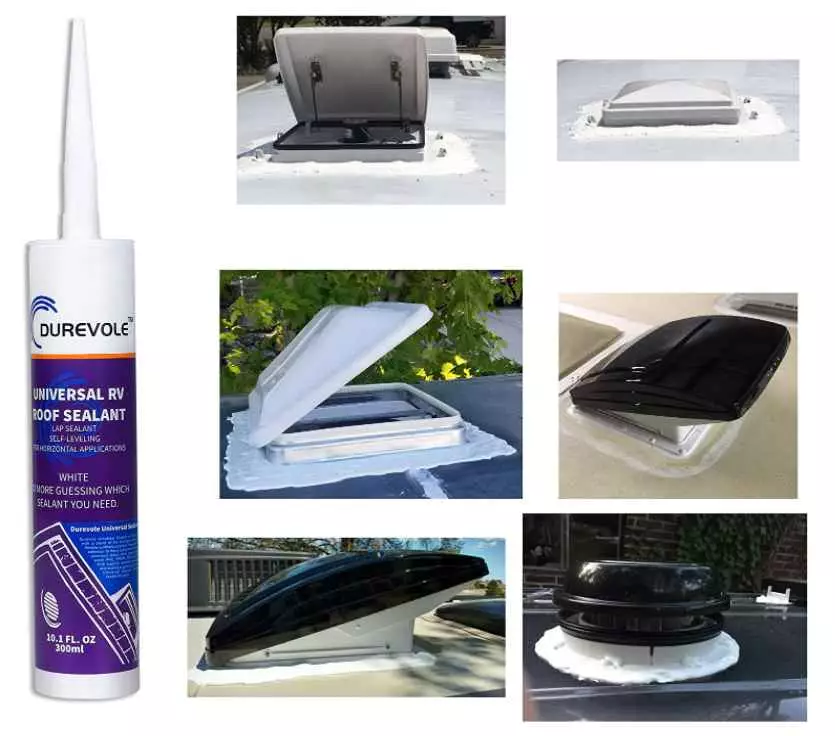
Dicor RV Roof Sealant
The Dicor RV roof sealant is an RV roof sealant based on acrylic. It is not the best option for RV rubber roof sealant. The price can tempt customers. However, Dicor RV roof sealant requires many coats and it is less durable when compared with silicone RV roof sealant.
- USE: This acrylic roof coating protects and beautifies metal RV roofing
- TEMPERATURE REGULATING: Brilliant white hue provides a superior reflectivity, thereby lowering interior temperatures
- COMPATIBILITY: For use on metal RV roofing only (not recommended for EPDM rubber or TPO roofing)
RV Roof Sealing Tape. For very small and faster repair, an RV roof sealant tape can be very helpful when the road is detected a small leak. These special sealing tapes are manufactured with an adhesive sealant suitable to work as an RV sealant. The sealant forms an airtight bond with the roof to lock in moisture and, consequently, stop the leak. Most can expand and contract with the roof depending on weather conditions and can last for several years.
RV Sealant and RV Roof Coatings Prices
Less than $20: mostly find all the RV roof sealant products pricing less than $20. The quality of the formulations varies quite a bit, However, it is possible to find good quality at a very good price.
$20-40: the mid-range houses a wide variety of products, from RV sealants to coatings, in several different formulations. Quality is usually good to very good, but even so, be aware of the brand you are buying from.
More than $40: entire roof coating kits. Also, a couple of more expensive formulation options. The best quality is priced a bit higher, but you’ll get what you paid for. Durable silicones options are in this price range.
Key Features of RV Roof Sealant
RV Sealant vs RV Coating – What do I need
RV Sealant and RV coating serve different purposes. However, sealant and coating products are very similar. If you are looking for a product that will insulate your RV, protect it from weather damage in various weather conditions and add structural integrity, you will want an RV coating product. If, on the other hand, you want to repair cracks or leaks in the roof or other tile involving small areas, a sealant is a better choice for the job.
RV Sealant Formulation
The material your liner or sealer is made of makes a big difference in terms of its performance. When it comes to gluing sealant and tape sealant, the formulation itself matters less than the overall quality of the product, but RV roof coatings are made of very different materials.
What is the Best RV Roof Sealant?
Speaking about weather resistance, the Best RV Roof Sealant is silicone-based (Order here). Although, RV Roof Sealant is based on acrylic and urethane serves very well to the sealant purposes.
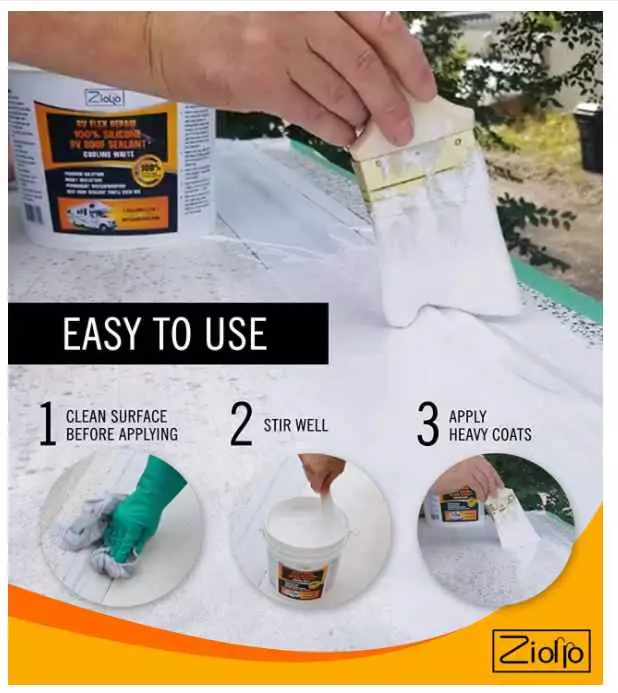
- LIFETIME WARRANTY & GUARANTEE - No other RV product on the market compares to our RV Flex Repair's Quality or Lifetime Warranty
- RV ROOF MAINTENANCE - The easiest, most efficient way to complete your RV Roof Restoration in 1 weekend is with the RV Flex Repair System; Compatible with RV Flex Repair Self Leveling Caulking Lap Sealant and Roof Seam Tape
- ECO-FRIENDLY PRODUCTS - Ziollo professional-grade RV Roof Sealant non-hazardous formula is safe to use indoors and outdoors, non-toxic to you, your family, or pets
RV Roof Sealant Ease of application
RV Roof Sealant formulations differ quite a bit in how they are applied, how long they take to dry, and how many coats they need to work most effectively. Silicone is the Best RV Roof Sealant and one of the easiest products to work with. More expensive but durable.
Silicone RV Roof Sealant dries quickly, needs only one coat, and is easy to apply.
Acrylic (such as Dicor RV roof sealant) and urethane RV Roof Sealant products vary, but many require at least one coat of primer and several coats of the product to reach their maximum capacity.
Other Considerations for RV Roof Sealant
Type of roofing material. Rubber roof sealants for RVs (EPDM or TPO roof) are the most common type of RV roof, so please choose a formula that can bond with rubber and is non-corrosive to the material. Any other material (glass fiber or metal) is usually compatible with common sealants or coatings, but be sure to check the product manual to understand the type of material it is designed for.
Elasticity. To resist temperature changes, you will need an elastic or flexible sealant or coating that can stretch or shrink with the applied surface. In short, make sure it has enough tensile strength to withstand exposure to different temperature conditions.
Packing size. Consider how much of your roof needs to be repaired or how much you want to repaint. This will help you decide whether to invest in a large bucket of paint or a roll of sealing tape.
Color. Sealant and coating products have several different colors, including transparent and white. Remember, bright colors will reflect more sunlight.
RV Rubber Roof Sealant: Polyurethane Hybrid Sealant
RV Rubber Roof Sealant
Polyurethane Hybrid Sealant is a favorite among campers and RV owners alike. This polyurethane RV roof sealant is one of the best available.
Polyurethane RV roof sealant is designed for use on RV rubber roofs, it’s ideal for sealing rips and cracks, and for waterproofing air conditioners and vents. The UV-resistant formula makes it resistant to summer heat. Once the Polyurethane RV Sealant is applied, it expands and shrinks with your RV roof fixing cracks and preventing degradation. It is also non-polluting and non-toxic, so it protects your health and the environment while you use the product. The bright white colors make it an excellent choice for replacing RV rubber roofs. Overall, the product is really easy to work with and requires fewer coats than the competition. The formula can be used safely in the sun, and will not foam or break even after first use.
What didn’t completely sell us was the fact that it’s an acrylic formulation (for example Dicor RV roof sealant), which means it won’t be as durable as a silicone one. It is still a great product and can do the job very well, but remember that in a few years, you will need to reinstall the RV roof.
Polyurethane RV Roof Sealant
Polyurethane RV Roof Sealant works extremely well to create a secure secondary seal along the edges, vents, and bolt heads of your RV’s roof. Polyurethane RV roof sealant adheres to several different surfaces, including wood, vinyl, aluminum, galvanized metal, fiberglass, etc., it is ideal for a wide range of different RVs. Polyurethane RV roof sealant is also compatible with EPDM and TPO sheets, and the white color of the sealant makes it blend perfectly with most RV roofs. As a self-leveling sealant, Polyurethane RV roof sealant is best used on horizontal surfaces because the formula is too liquid to be used vertically. When using Polyurethane RV roof sealant, remember to use a larger amount to cover the screw heads so that the product can spread and level. If you have a leak or hope to prevent a leak by sealing all possible nooks and crannies, Polyurethane RV roof sealant is the product for you.
One major drawback is the size of the tube it comes in. If you have a large RV and want to seal the entire roof, they might need up to 5 or more tubes of Polyurethane RV roof sealant to finish the job. But on the other hand, water damage will be more expensive to repair than sealing everything properly. It is also worth mentioning that this formula has a learning curve before you become an application expert.
RV Roof Sealant Repair Tape
For a quick and hassle-free solution to leaky RV roofs, comes the flexible repair tape for RV roof sealant. The RV roof sealant tape is a white tape that measures 50 feet long and is designed with an adhesive butyl sealant.
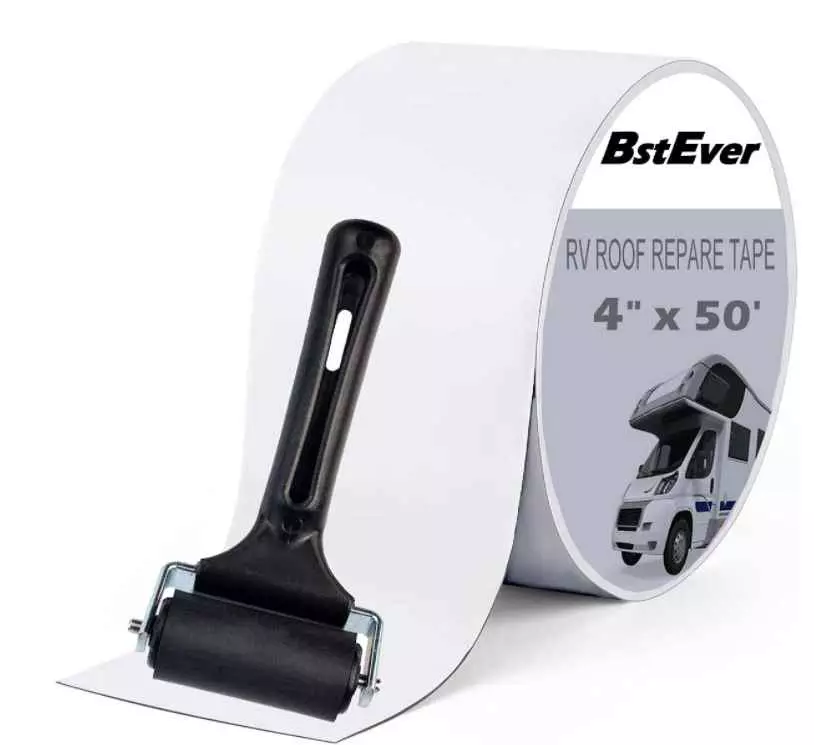
- Extra Value: Come with Rubber Roller, A free roller to adhere the butyl tape better.
- DIY Easy Installation: From novices to professionals, anyone can fix a leaky RV roof. The toughest part of the whole installation is peeling off the backing to expose the adhesive, but don’t worry, Camp’N has fixed that by providing an exclusive easy peel backing. No more fighting the backing and making a mess.
- The Camp’N RV Roof Repair Tape creates an instant bond that seals out water, moisture and air to create a strong, flexible watertight barrier. It’s VERY IMPORTANT to make sure the area to be repaired is thoroughly cleaned and dried per the instructions. Adheres to many common RV roof materials
The adhesive butyl sealant on the RV roof sealant tape forms a waterproof seal. It works with a roof made of plastic and EPDM rubber materials (RV rubber roof), as well as other materials such as fiberglass, metal, and almost all surfaces except silicone.
The RV roof sealant tape works best when applied to a clean surface, and to effectively seal large cracks, you can overlap the tape over itself. You can also get a steam roller in the packaging to help activate the sealant on the surface. Once the RV roof sealant tape has fully adhered to the surface, it creates a waterproof coating that remains flexible even as the temperature changes. The RV roof sealant tape also resists UV damage.
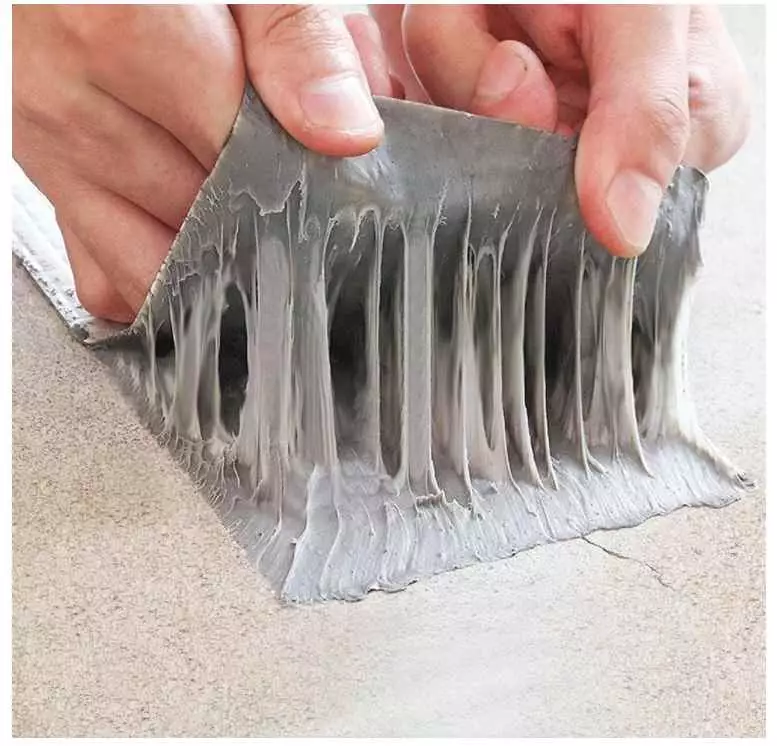
- 【Professional RV/Mobile Repair Tape】Getting RV roof repairs is expensive especially if the problem isn’t small. WELLUCK industrial-grade RV Roof tape, specifically designed for the RV'er, forms an incredibly tough and durable repair. Effectively stop leaks and binds cracks, tears and seams.
- 【UV-Resistant and Weatherproof】WELLUCK leak-free roof tape creates a waterproof airtight barrier with no additional sealing required and remains flexible to temperatures as low as -40ºF making it virtually impossible to thermally shock the seam causing a leak. Not need frequent applications, saving you money in the end.
- 【Natural Pure White Quality】No binders or fillers roofing tape, closer to RV roof color! White finish also is effective in reflecting sunlight. Besides, it won’t give a messy asphalt look and ruin the look of your RV roof fixtures.
You should be warned that the RV roof sealant tape is quite sticky, so you risk wasting too much if you pull too much. It can stick to your hands or surrounding surfaces that you do not intend to seal. Work with small areas at a time.
Not only can it be used to coat the roof of your RV, but the RV roof sealant tape is also suitable for any other use case where you want to put down a waterproof, flexible rubber coating. The formula is designed to be softer. It can be rolled, poured, or brushed on and leveled quickly. The RV roof sealant tape can seal water and moisture and is mold-proof. Another important feature is that the formula has UV resistance and non-flammability, is non-toxic and safe and can be used around plants and animals. It also prevents rust and corrosion and resists chemicals. If you need something that can be hit, this may be your choice.
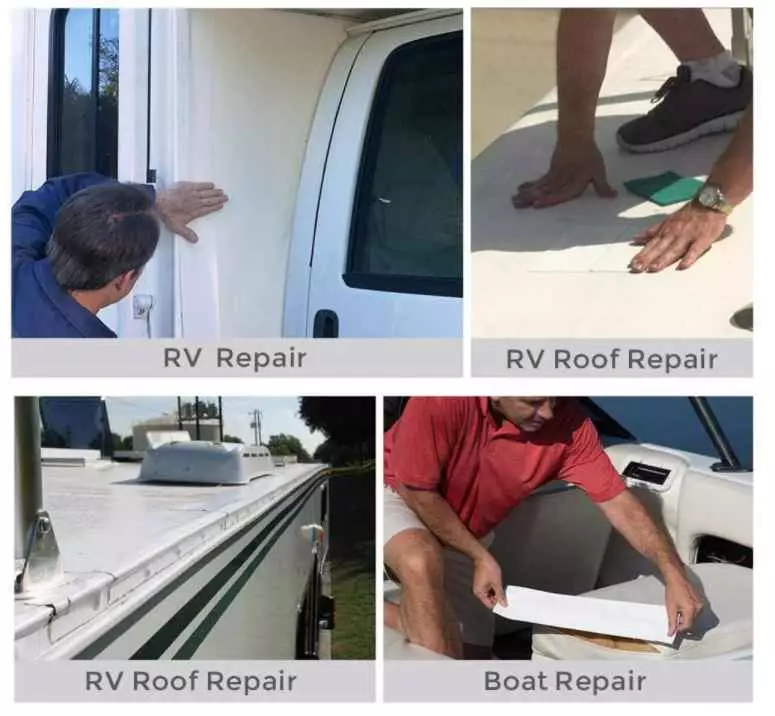
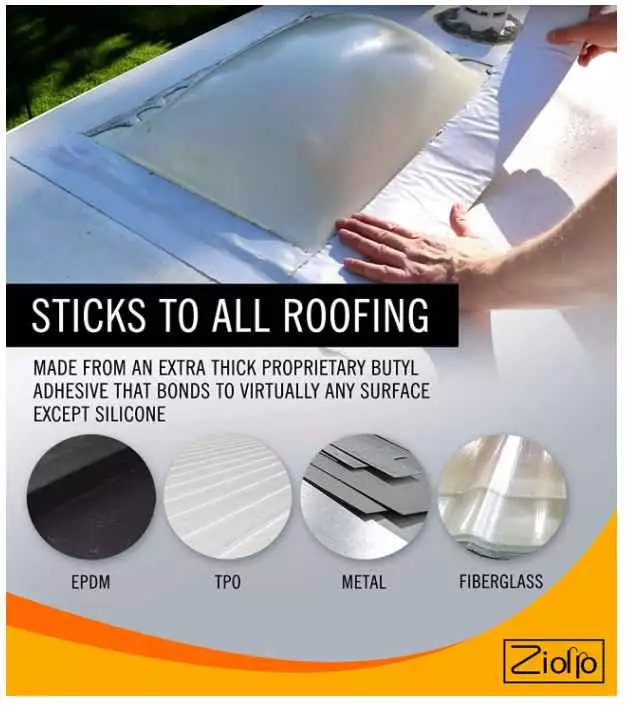
- LIFETIME WARRANTY & GUARANTEE - No other RV product on the market compares to our RV Flex Repair's Quality or Lifetime Warranty
- RV ROOF MAINTENANCE - The easiest, most efficient way to complete your RV Roof Restoration in 1 weekend is with the RV Flex Repair System; Compatible with RV Flex Repair Self Leveling Caulking Lap Sealant and RV Flex Repair 100% Silicone Roof Coating
- DIY RV WEATHER PROOFING - Tape that has a strong and air-tight sealing designed for EPDM Rubber Roofing, TPO, Metal, Fiberglass; It sticks to virtually all surfaces except silicone
Tips for RV Roof Sealant and RV Roof Coating
It’s a good idea to apply thin coats of acrylic (for example Dicor RV roof sealant) or urethane RV roof coating instead of a thick one. This will help the product work more efficiently.
Use a caulking gun to apply a sealant and make the coating easier to apply. Some sealant products already come in similar containers for just that reason. If yours doesn’t, fill it with a caulking gun and make the task of repairing your RV’s roof easier.
Be sure to wash your RV thoroughly before applying any sealant or coating product. You want to make sure everything, especially the roof, is clean and dry, and follow the additional preparation steps that accompany your product instructions.
It is a good idea to work in a shaded, well-ventilated area to allow the product to be set properly. Too much heat and sunlight can warp the roof a bit and make the coating uneven.
The easiest way to repair roof leaks is with sealing tape. It is fast, easy to use, and most importantly, very effective in getting the job done.
Frequently Asked Questions
What Is The Best Way To Apply RV Roof Sealant?
Even if you have the Best RV Roof Sealant on the market there are a few steps before applying the roof sealant or roof coating. Check out the steps before applying any roof sealants or roof coating.
Firstly, be sure your RV is clean. Follow any other preparation steps mentioned on the product you purchased by the vendor before applying RV roof coating.
Denatured alcohol is a good option to apply to the entire RV roof, after removing any old sealant. Cleaning the surfaces with alcohol to make sure that the new coating adheres to a clean surface. Then, just follow the instructions that came with the coating.
What Formulations Should I Look For In RV Roof Sealant?
You have a couple of different options. RV EPDM rubber (Rubber roof sealants for RVs) lining products are suitable for most RVs, and it is a very effective weather-resistant elastomer formula. KST coatings are also a good option, as they exhibit many of the same properties and handle UV rays with ease. If you have a fiberglass roof, you’ll want something made specifically for that type of roofing material to make sure everything is well sealed.
How Many Coats Do I Need To Use To Repair My RV Roof?
Not as much as you might think, because when sealing cracks in the RV roof, in fact, the less the better.
If you are doing a full coating, the number of coats you need to do this will vary depending on the type of product you are using and also the type of RV you have. For example, acrylic (Dicor RV roof sealant ) and urethane coatings require the use of a primer as well as several coats in general.
How Does Sealer Differ From Coating?
The quick and easy answer is that sealants are usually used to repair cracks and seal roof joints to prevent water leakage.
RV Roof Coating is used to cover the entire roof, playing the role of heat insulation and weatherproofing. They can be used together or individually.
What Can I Use To Clean The Roof Coating Once It Is Applied And In Use?
Once applied and used, what can I use to clean the roof coating? There are many different cleaners you can use. However, avoid cleaners containing: rough abrasives, petroleum, oil, or citrus ingredients. Cleaners containing these chemical compounds would damage the covering.
How Often You Should Clean Your RV Rubber Roof?
How to Clean RV Rubber Roof?
Normally, cleaning your RV rubber roof between three to four times a year is enough. However, if the RV is parked under trees, it is recommended to clean and inspect more frequently. Do not use cleaners containing petroleum solvents, harsh abrasives, or citric acid on RV vinyl roofs or RV rubber roofs.
Can I Use A Pressure Washer To Clean My RV Roof?
Using a high-pressure washer before painting the roof is a good way to remove any buildup and stubborn dirt.
- Once the coating is applied, you should use a gentler water jet for cleaning.
- High-pressure cleaners can damage seals, coatings, and even paint jobs.
How to Remove Sealant from RV Rubber Roof
RV Roof Maintenance
You should already be performing an annual maintenance check on your camper van or RV to stay on top of any needed repairs.
- The RV annual maintenance check must include the roof.
- Look for any signs of cracks or damage.
- Check the areas around the roof vents, air conditioners, wires, or exhaust vents that protrude from the interior of the camper, campervan, RV.
- Due to high temperature, road vibration, and long-term driving, the sealant around these areas will usually dry out and separate.
- If you start to see any signs of wear, apply a new coat of roof sealant to the area.
- This is an inexpensive repair that can save a lot of time and money down the road.
Cleaning and protecting your RV
Typically, cleaning your RV roof between three to four times a year is enough. This will help prevent deterioration and stains caused by tree sap, bird droppings, algae, and mold buildup. If you park your RV under a tree, clean it more frequently. Check out the following steps for cleaning and protecting your RV:
- Check the user manual to see if you can walk on the roof.
- Safety first! Be very careful where you step on it, as you may trip over a lot of things and wet surfaces may be slippery.
- If you are not used to working on the roof, please contact the RV service company to do it for you.
- Use appropriate cleaning materials and methods.
- Check the manufacturer’s manual looking for the type of soap or cleaning material recommended for RV roof maintenance.
- Do not use cleaners containing petroleum solvents, harsh abrasives, or citric acid on RV vinyl roofs or RV rubber roofs.
- Spray the roof following a rinse step that will help you effectively remove any dirt and debris.
- Apply the cleaner and scrub in a circular motion.
- Cleaning tools: sponge, medium bristle brush, wash mitt, or rag to clean the entire surface.
- It is recommended to work in small areas at the time.
- Rinse everything with clean water, including the sides, preventing soap residue and damage to decals.
- If the roof is extremely dirty, you may want to cover the sides with plastic sheeting.
- Apply a protective treatment by following the vendor’s instructions.
- If your roof is made of rubber, like most modern roofs-applying additional treatment can help protect it from UV rays and dirt buildup. Just wait until the roof is completely dry before using.
- Inspect the entire roof looking for signs of damage, such as cracks, peeled off, scratches or perforations, or any other
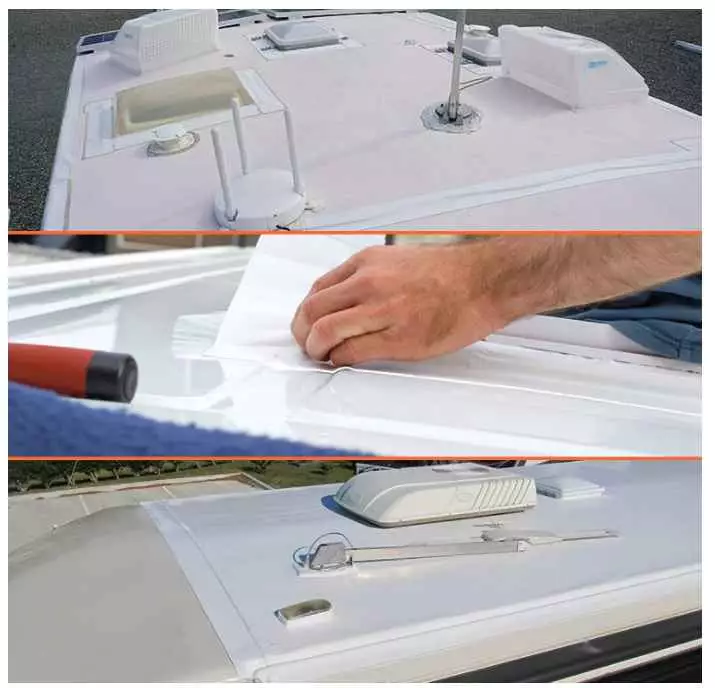
RV Inspection Tips Before You Hit the Road
There is an assortment of sealant and gasket materials utilized in the RV business and recall that every one of them will fall apart from openness to the components and warm development.
- Have them looked at like clockwork. Most RV makers suggest assessing gaskets completely like clockwork. Actually, take a look at your proprietor’s manual for qualities specific to your model. A little break in the joint can, over the long run, become a costly fix that a protection strategy may not cover.
- Look at all joints. On the off chance that you find any indications of breaking in the joint sealant or some other worries about harm, kindly contact an authorized proficient for fix choices.
- Search for tears or cuts. The elastic material will in general have tears in the roofing material itself brought about by things like tree appendages.
- Assess the apparatuses. Check the cooler rooftop and capacity tank vents for harm or deterrents, just as the climate control system cover to ensure there is no harm and the mounting is satisfactory.
- Kindly contact an authorized proficient to fix choices. Try not to give a little tear access to your RV’s rooftop to transform into something greater and more costly. Wash and investigate your RV frequently and fix any issues quickly so you don’t need to stress over the rooftop keeping you from driving securely during your outing.
Final RV Sealant and RV Coating Thoughts
Heng’s rubber roof coating works great for RV roof coating for maximum adhesion that allows for a watertight roof coating. It helps seal leaky roofs and resists damage from sun exposure.
- Designed for use over RV rubber roofs, at seams and tears and to seal vents, air conditioners, etc
- It is UV resistant and expands and contracts with roofs
- Resists cracking and withstands impact, non-polluting and non-toxic
If you have small leaks at the edges, EPDM Self-Leveling Sealant is a good option for RV roof sealant. It is ideal for sealing small leaks.
RV Roof Sealant silicone-based is the best RV Roof Sealant.
Want to Read More? NADA Guide for RV: What Is My RV Trade-In Value
Want to Read More? What to Know Before Buying an RV – Checklist











